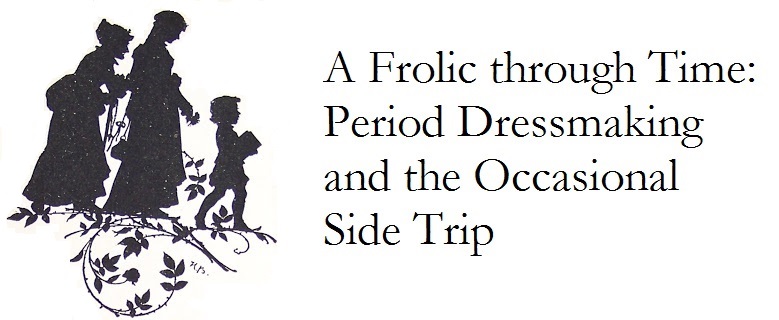
Those of us who love Edwardian fashion are often curious about hobble skirts. Their cut seems so modern and so antiquely confining at the same time.
The blog Edwardian Promenade has written up a fine, brief history titled, no surprise here, The Hobble Skirt.
Photo: La Soiree Toscane: Robe d'apres-midi de Doueille. 1913. NYPL image no. 824734.
After reading the article, I made my way to a favorite research resource, The New York Times site, and entered "hobble skirt" into its search engine. Turns out, the paper and the public were fascinated by the fad, too:
"'THE HOBBLE 'IS THE LATEST FREAK IN WOMAN'S FASHIONS; Skirts Are So Tight Around the Ankle That Locomotion Is Seriously Impeded and Speed Is Impossible" read one headline on June 12, 1910.
Freakish accidents and falls soon followed:
"INJURED IN "HOBBLE" SKIRT.; Mrs. E. Van Cutzen, While Alighting from Runabout, Falls on Pavement." August 5, 1910. Mrs. Van Cutzen belonged to the fashionable set, apparently, for she fell out of her electric runabout car in front of the casino in Newport, Rhode Island. Troubles continued: "Hobble skirt caused her death" read another headline, dated September 1, 1911.
There were those writers who praised the skirts as a method of instilling grace into what the writer considered the undignified striding about of American women."Walking in Hobble Skirts", published in 1912, reads more like a polemic than anything else.
 The Parisian fashion world's claim that the fashion was American, and not their own design? Read this article by a non-plussed reporter: "HOBBLE SKIRT IS AMERICAN.; So Paris Man Dressmakers Declare After It Breaks Parislenne's Leg." August 14, 1910.
The Parisian fashion world's claim that the fashion was American, and not their own design? Read this article by a non-plussed reporter: "HOBBLE SKIRT IS AMERICAN.; So Paris Man Dressmakers Declare After It Breaks Parislenne's Leg." August 14, 1910.Photo: "Mother, you stand like last year." 1912. NYPL image no. 817969. In this image, two willowy daughters posing in the fashionable, willowy stance tease their mother, whose posture reflects the straight-front corset of previous years, which pushed out the chest and derriere at once, creating a "walking into the wind" sort of look.
Oh, and there's much more, if you continue the search: articles about women in Washington winning a fight to get trams they can climb into without tripping; the Pennsylvania Railroad barring them; Queen Mary's war on the fashion appearing at court, hobble skirt races, an actual bill introduced to regulate the width of the skirts, claims that the fashion hurt trade, and report after report of accidents.
And then the fad faded away, like the Dolly Varden dress, and so many fads before it and since then, and the editors went on to fresh and more important news...World War I.
Are You Looking for Hobble Skirt/Titanic Era Patterns?
There are many free sources online for skirt and dress patterns of this era. Here are a few of them:
- The Ladies Tailor, Vol. XXVII. No. 3. March 1911, London. On the Costumer's Manifesto site. These patterns are for jackets.
- Edwardian patterns from The Ladies' Treasury. An overcoat, evening dress, and suit.
- Thornton's International System of Ladies' Garment Cutting
(London, c.1912). Excellent resource with tons of patterns. I have drafted and made a pretty two-piece skirt from this collection. To draft the patterns, print them out at the largest size you are able: you may have to enlarge the images using Photoshop or similar program. The results will be pixelated but with care you can see most all of the text. On the Costumer's Manifesto site. - La Couturiere Parisienne, 1900s pages. Quite a few patterns, including for underclothing.
- Shelter and Clothing: a Textbook of the Household Arts. (1913). Drafts of underclothes and gored skirts. On Cornell HEARTH site.
- Text-book on domestic art, with illustrations and drafts. (1911). Lots of drafts and excellent directions. I made both a lovely petticoat and a skirt from this book. On the Cornell University HEARTH site.
- Good Housekeeping. Fashion images and if you look carefully, there may be drafts and directions, especially for accessories. On Cornell HEARTH site.
- Cornell HEARTH site. Browse the selections from the Edwardian and teens eras to find gems, reproduced in their entirety. There is more than what I have shown above!
- The Human Ecology Collection: All Sewn Up. Millinery and dressmaking books in their entirety, a few from the Edwardian era and more from the teens era. From the University of Wisconsin - Madison.

4 comments:
Thank you for this fascinating post full of information about hobble skirts! I always did wonder how ladies got about with any ease of movement while wearing this style. I assumed there had to be some hidden, secret kick pleat or extra panel, somewhere, to allow easy striding. I see now I was wrong in my assumptions!
I love the NYT archive. It's so wonderful when needing to see what life was like back in the 19th century and early 20th. Thanks for linking to my blog!
Dear Sarah Jane,
'Evening to you! Actually, at some point those little slits and kick pleats did make their way into designs. There's an image of a model at the races in England showing off such a skirt -- was it in 1914? It caused a bit of a stir because the lowest part of her legs, just about the ankle, were displayed. See Alison Gernsheim's "Victorian & Edwardian Fashion: a Photographic Survey" and look in the final set of photos. I'd go get the book and give you the page number but my sewing room is also Christopher's nursery :}
Very best to you and yours,
Natalie
Dear Evangeline,
So happy to link to your blog! I read it every chance I get...the Edwardian era seems under-studied to me and it's a delight to find an historian willing to take a close look at the period.
Very best,
Natalie
Post a Comment